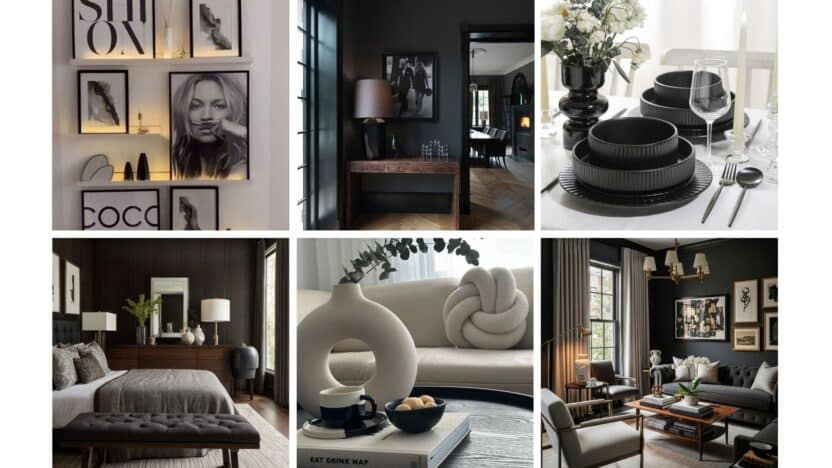Dark colors can transform your interior spaces from ordinary to extraordinary, creating depth, sophistication, and visual intrigue that lighter palettes simply cannot achieve. Whether you’re considering a dramatic accent wall, investing in rich furniture pieces, or adding moody accessories, dark hues offer endless possibilities for personalizing your home.
Dark colors work as powerful design tools that allow lighter elements to stand out while creating cozy, intimate atmospheres that feel both elegant and inviting. The key lies in understanding how to balance these deeper tones with proper lighting, strategic color pairings, and thoughtful placement throughout your space.
You don’t need to commit to an entirely dark room to harness the power of these rich colors. From deep teals and charcoal grays to sophisticated blacks and midnight blues, dark accents can be incorporated gradually through walls, furniture, and accessories to create the perfect moody aesthetic for your personal style.
Key Takeaways
- Dark colors add depth and character while allowing lighter furniture and decor to create striking visual contrast
- Proper lighting and strategic placement are essential for preventing dark interiors from feeling dull or overwhelming
- You can incorporate dark accents gradually through walls, furniture, or accessories without committing to a completely dark room design
Why Choose Dark Colors for Interior Accents
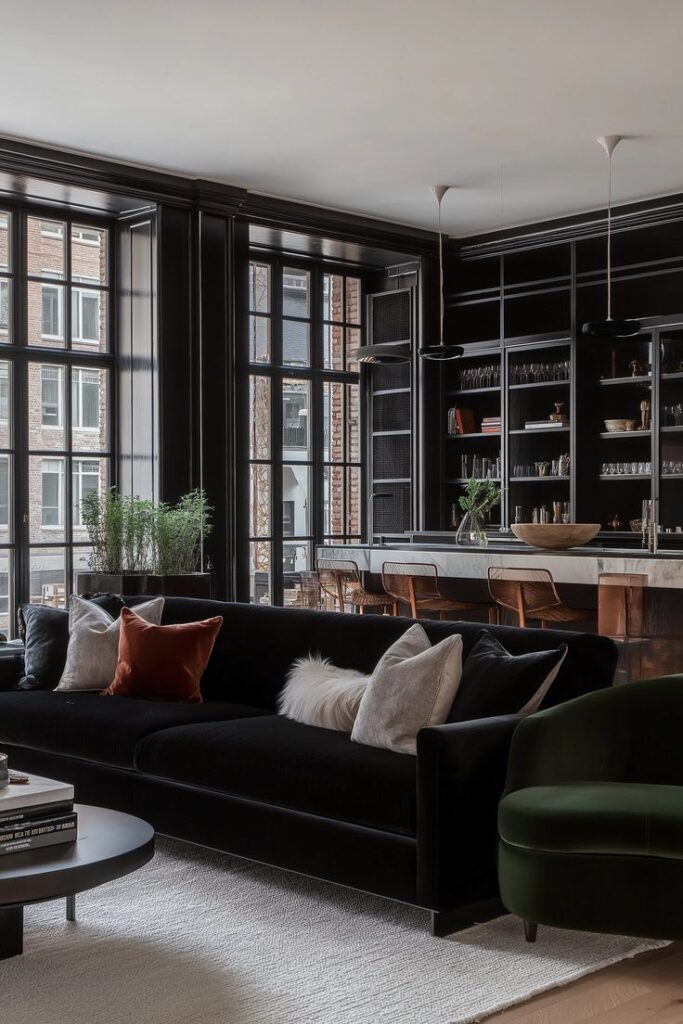
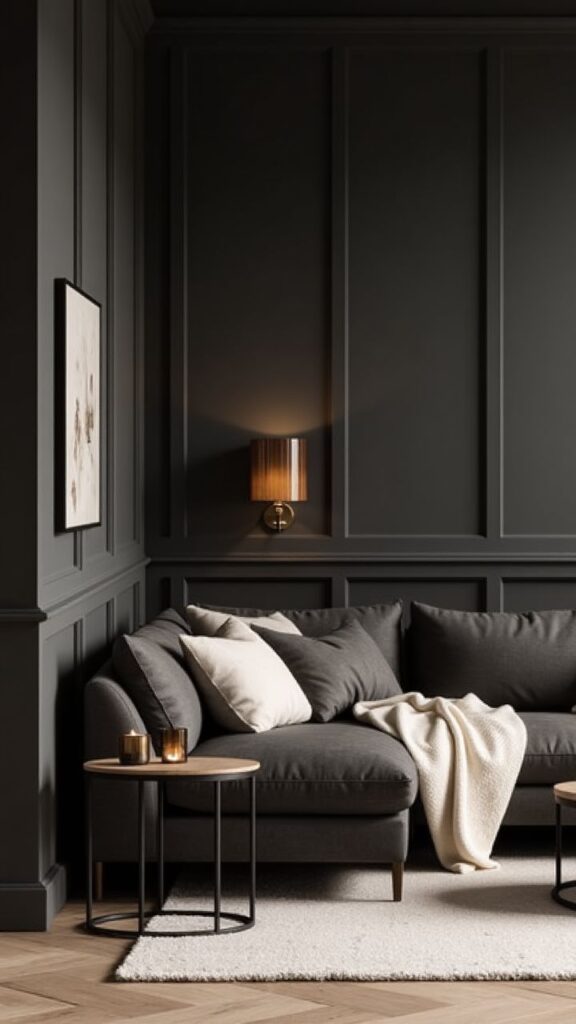
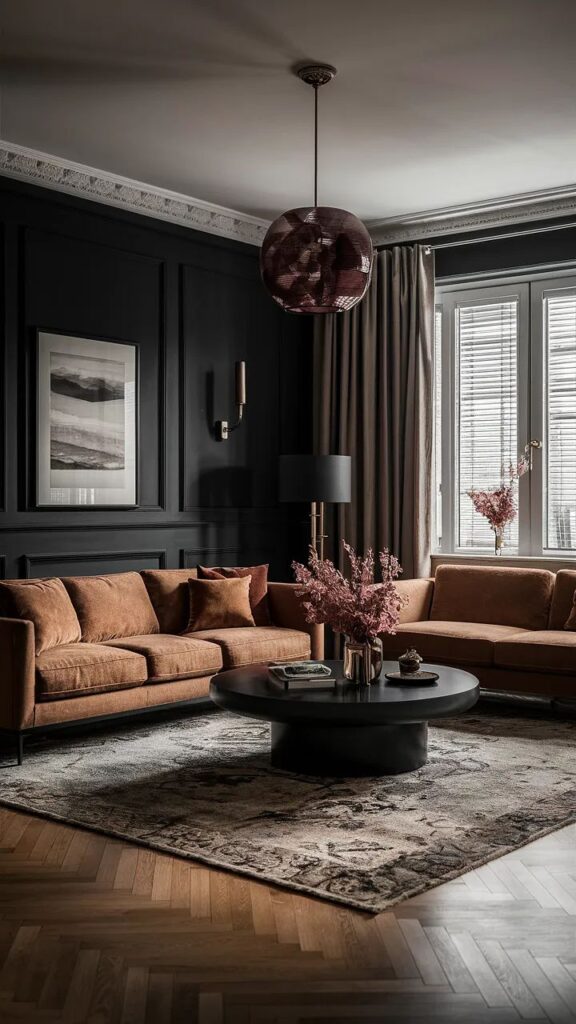
Dark colors transform spaces by creating sophisticated environments that feel both intimate and elegant. They offer unique advantages for establishing visual depth and enhancing the overall character of your home.
Benefits of Dark Hues in Modern Spaces
Dark colors instantly elevate your space’s perceived value and sophistication. They create striking visual contrast that makes lighter elements pop dramatically.
Space Manipulation Benefits:
- Make rooms feel taller with dark accent walls
- Create intimate conversation areas
- Add depth to flat surfaces
- Enhance architectural details
Dark accent walls work exceptionally well with neutral furniture and metallic finishes. You can use them to define specific zones in open floor plans.
These colors hide imperfections better than lighter shades. They also create a timeless backdrop that won’t look dated in years to come.
Dark colors provide excellent contrast for artwork and decorative accessories. Your colorful pieces will appear more vibrant against deep backgrounds.
Creating a Cozy and Moody Atmosphere
Dark interior design transforms your space into a warm retreat. These colors naturally create intimate settings perfect for relaxation.
Cozy Atmosphere Elements:
- Deep blues for calming bedrooms
- Charcoal grays for sophisticated living rooms
- Dark greens for nature-inspired spaces
- Rich burgundy for dining areas
You’ll find dark colors work particularly well in rooms where you want to unwind. They create cocoon-like environments that feel protective and comfortable.
Moody interior schemes help reduce visual distractions. This makes spaces feel more focused and intentional.
Dark walls make rooms feel smaller in a good way. They create snug, welcoming environments rather than cavernous spaces.
Balancing Drama and Sophistication
Dark colors add dramatic impact without overwhelming your space when used strategically. The key lies in thoughtful placement and proportion.
Balance Techniques:
- Use dark colors on one accent wall only
- Pair with light-colored furniture
- Include metallic accessories for contrast
- Add warm lighting to prevent harsh shadows
Avoid covering all walls in dark colors as this can feel oppressive. Instead, choose focal walls behind beds or sofas for maximum impact.
You can incorporate dark colors through furniture pieces like velvet sofas in deep emerald. This approach lets you experiment without permanent commitment.
Dark trim and window frames create sophisticated contrast with lighter walls. This technique adds architectural interest and modern appeal to any room.
Designing with Dark Walls
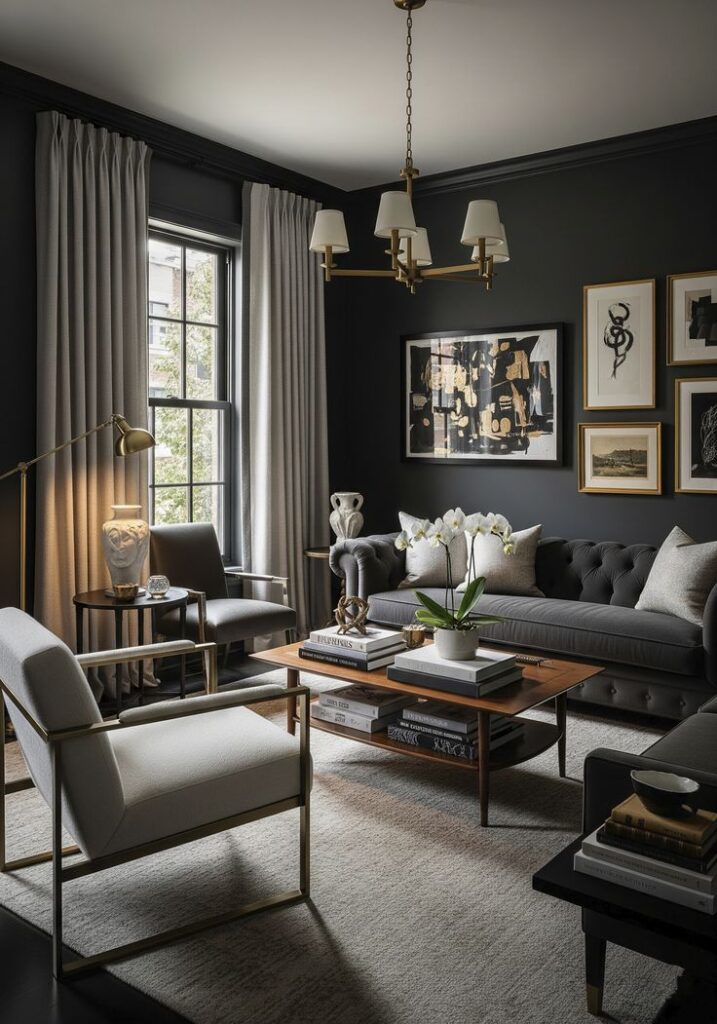
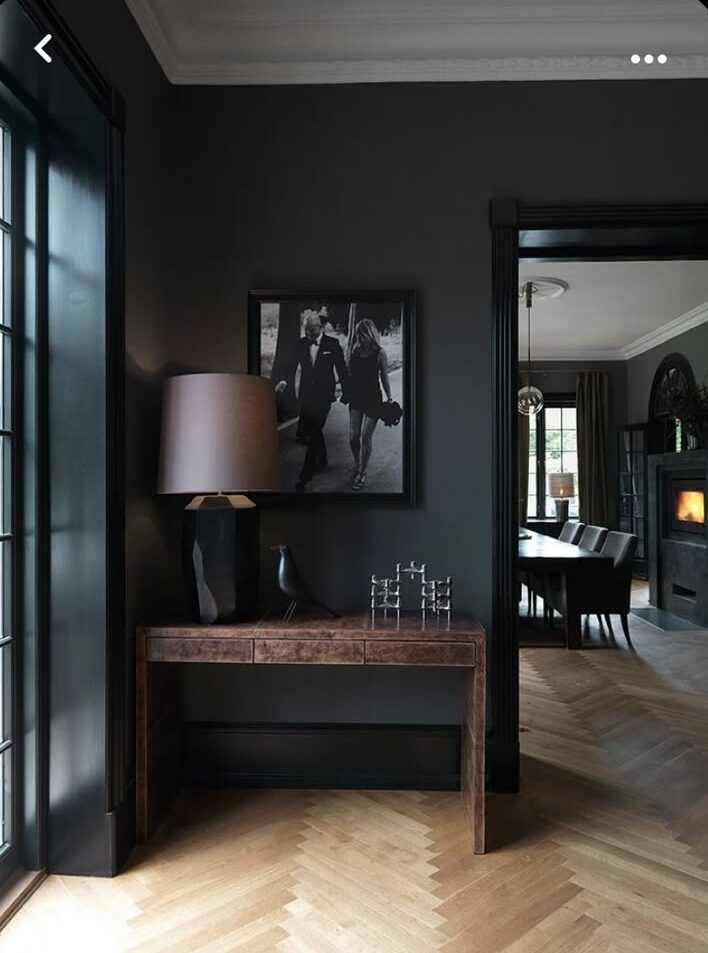
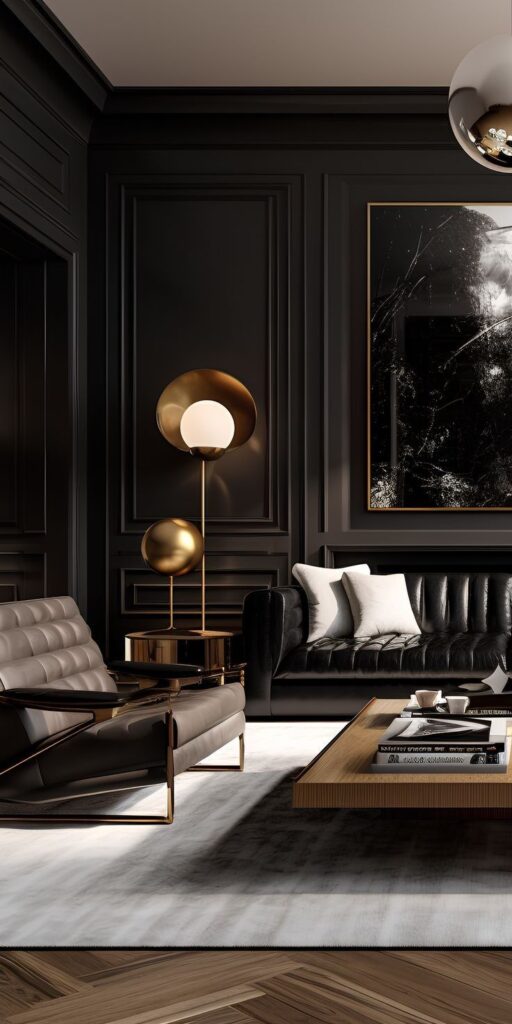
Dark walls create dramatic focal points that transform room dynamics through strategic color placement and thoughtful contrast. Success depends on balancing deep hues with proper lighting and complementary elements.
Accent Walls for Visual Impact
A single dark accent wall delivers maximum drama without overwhelming your space. Choose the wall behind your bed, sofa, or fireplace as your focal point.
Deep blues work exceptionally well for accent walls in living rooms and bedrooms. Navy creates sophistication while midnight blue adds depth. Charcoal gray offers versatility across different design styles.
Dark accent walls make rooms feel more intimate and cozy. They also highlight architectural features like built-in shelving or artwork displays.
Position your accent wall where it receives adequate natural light during the day. This prevents the space from feeling too enclosed or cave-like.
Consider the room’s proportions before committing. Accent walls work best in rooms with high ceilings or ample square footage.
Pairing Dark Walls with Contrasting Decor
Balance is essential when working with dark hues on walls. Light-colored furniture prevents the space from feeling too heavy or oppressive.
Incorporate warm wood tones like oak or caramel leather to soften the intensity. Avoid pure white furniture as it creates harsh contrast that feels disconnected.
Ambient lighting becomes crucial with dark walls. Layer different light sources including table lamps, floor lamps, and wall sconces to create warmth.
Metallic accents in brass or gold complement dark walls beautifully. These warm metals add richness without competing with the wall color.
Textured fabrics and materials add visual interest against flat dark surfaces. Consider velvet pillows, woven throws, or natural fiber rugs.
Popular Dark Wall Paint Colors
Your color palette should reflect the room’s purpose and existing elements. Dark teal brings sophistication with nature-inspired tranquility for dining rooms or studies.
Charcoal gray remains the most versatile dark wall color. It works with both warm and cool accent colors while maintaining a timeless appeal.
Forest green creates dramatic impact in bedrooms or home offices. This color pairs well with brass fixtures and natural wood furniture.
Black walls require confidence but deliver unmatched elegance. Reserve true black for rooms with excellent lighting and larger proportions.
Deep burgundy or wine colors add warmth to formal spaces like dining rooms. These colors create intimate atmospheres perfect for entertaining.
Choosing and Styling Dark Furniture
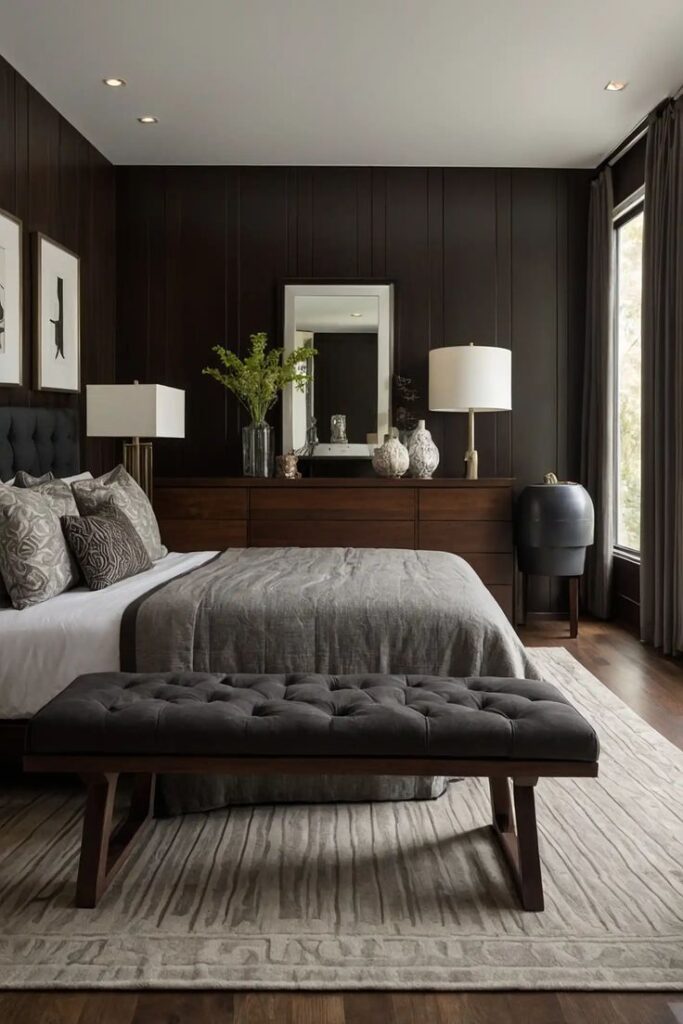
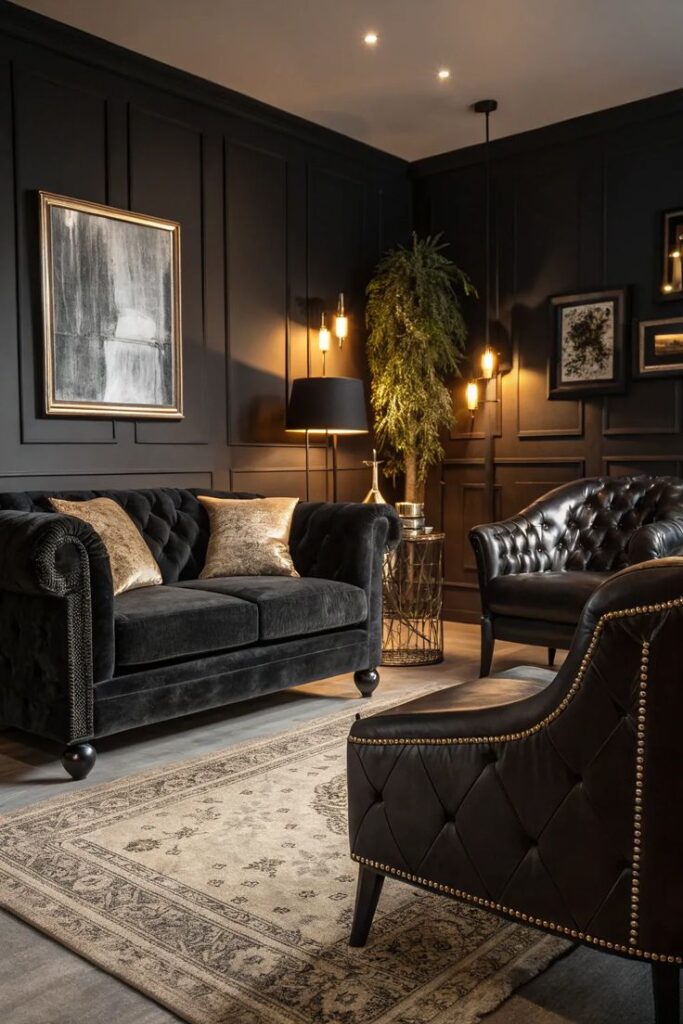
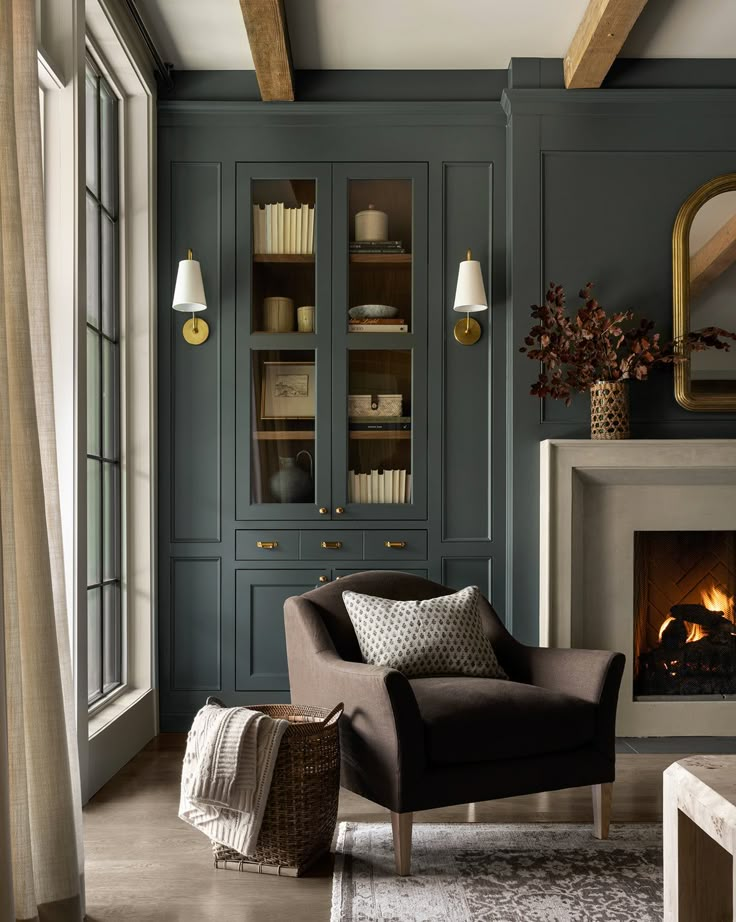
Dark furniture creates dramatic focal points while adding sophistication to any space. The key lies in balancing rich tones with complementary colors and selecting finishes that enhance your room’s lighting and overall aesthetic.
Dark Wood Furniture Inspirations
Dark wood furniture brings natural elegance and timeless appeal to your space. Mahogany offers rich reddish undertones that pair beautifully with warm neutrals. Walnut provides deep chocolate hues with distinctive grain patterns.
Ebony and black-stained woods create striking modern statements. These pieces work exceptionally well in contemporary and transitional settings.
Consider the wood’s undertones when planning your room. Cool-toned dark woods complement grays and blues. Warm-toned pieces harmonize with beiges, creams, and soft yellows.
Position dark wood furniture where it receives adequate light. Natural light enhances the wood’s grain and prevents pieces from appearing too heavy or overwhelming.
Selecting Upholstery and Finishes
Glossy finishes reflect light and make dark furniture appear more prominent. They work best in well-lit rooms with ample natural or artificial lighting.
Matte finishes absorb light and create subtle, sophisticated looks. These work well in cozy spaces where you want furniture to blend seamlessly.
| Finish Type | Best For | Lighting Needs |
|---|---|---|
| Glossy | Modern spaces | High light |
| Satin | Versatile rooms | Medium light |
| Matte | Traditional rooms | Any light level |
For upholstered dark pieces, choose fabrics that complement rather than compete. Light-colored textiles create beautiful contrast. Rich jewel tones like deep emerald or sapphire enhance the luxurious feel.
Mixing Dark and Light Furniture
Balance dark pieces with lighter elements to prevent overwhelming your space. Use the 60-30-10 rule: 60% neutral tones, 30% secondary colors, and 10% dark accents.
Pair a dark wood dining table with light-colored chairs. This creates visual interest while maintaining harmony.
Position dark and light pieces strategically throughout the room. Avoid clustering all dark furniture in one area, which can create visual weight imbalances.
Light-colored rugs, artwork, and accessories help break up dark furniture groupings. These elements add breathing room and prevent spaces from feeling too enclosed or heavy.
Dark Accessories and Decorative Accents
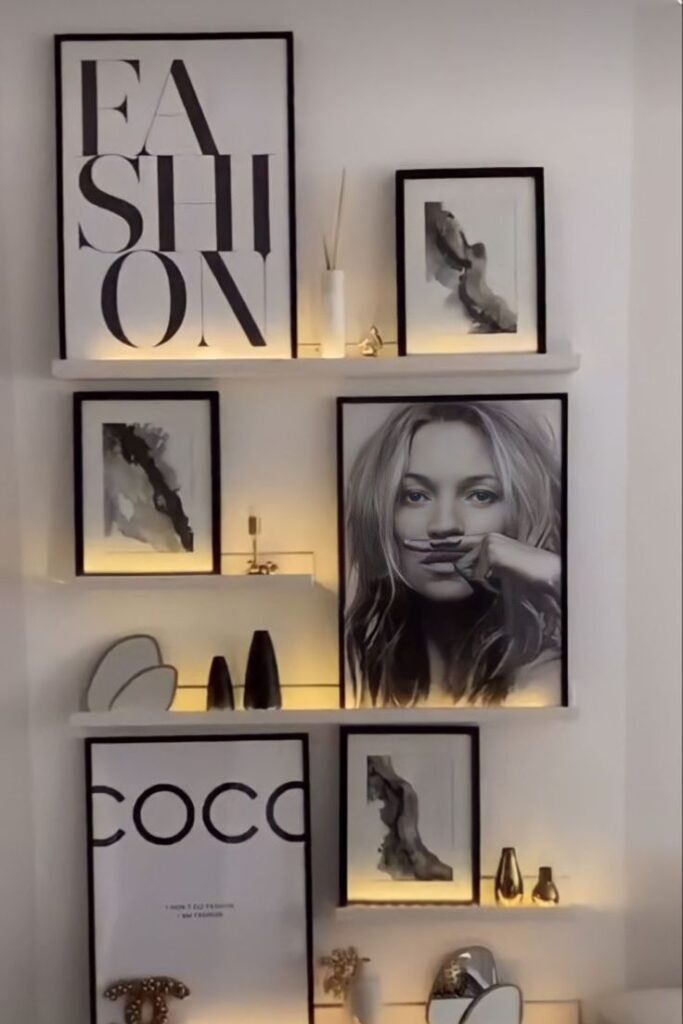
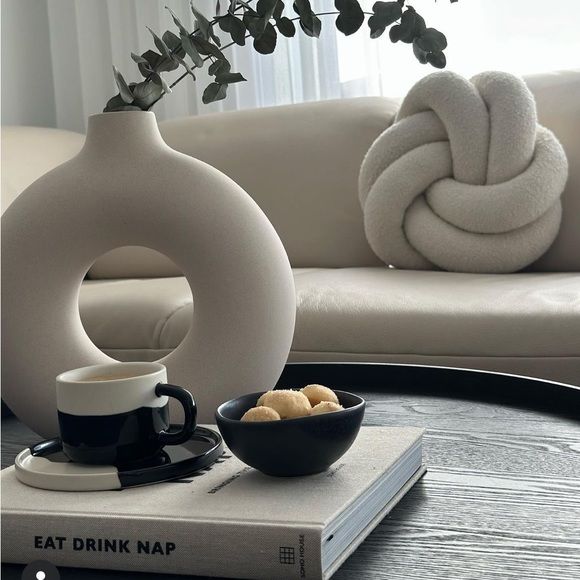
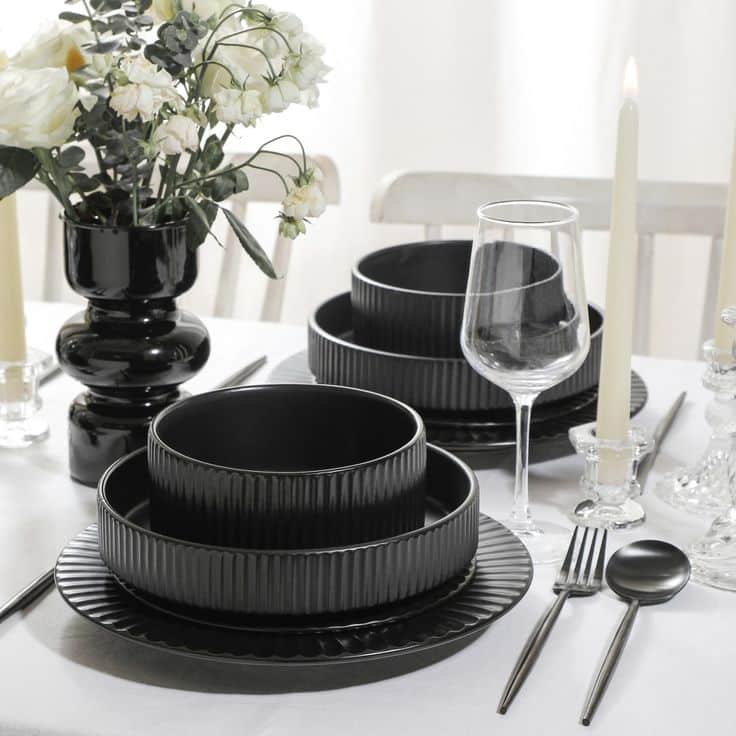
Dark accessories create dramatic focal points while maintaining design flexibility. These elements add sophistication through strategic placement of artwork, textiles, and reflective materials.
Statement Artwork and Mirrors
Dark-framed artwork commands attention without overwhelming your space. Black frames enhance colorful paintings and photographs by creating strong visual boundaries.
Large mirrors with dark bronze or matte black frames serve dual purposes. They reflect light while adding architectural weight to your walls.
Consider these dark artwork options:
- Charcoal drawings in black frames
- Photography with dark matting
- Abstract pieces featuring deep blues or blacks
- Vintage mirrors with oxidized metal frames
Position dark artwork at eye level for maximum impact. Group smaller pieces together to create gallery walls that feel intentional rather than scattered.
Oversized mirrors with dark frames work particularly well above mantels or console tables. The contrast between the reflective surface and dark frame creates visual interest.
Throw Pillows and Textiles
Dark throw pillows anchor lighter furniture while adding texture and depth. Velvet pillows in charcoal or deep navy provide luxurious contrast against cream or beige sofas.
Layer different dark textures for visual richness:
- Wool pillows in charcoal gray
- Leather cushions in deep brown
- Silk covers in midnight blue
- Linen throws in slate gray
Mix solid dark colors with subtle patterns. Geometric designs or tone-on-tone textures prevent dark textiles from appearing flat.
Dark curtains frame windows dramatically. Choose materials like heavy cotton or linen in colors such as charcoal, deep green, or rich burgundy.
Rugs in dark tones ground your furniture groupings. Persian rugs with dark backgrounds or solid charcoal area rugs define seating areas effectively.
Metallic and Reflective Accents
Metallic accents in dark finishes add glamour without excessive shine. Oil-rubbed bronze, aged brass, and matte black metals complement dark color schemes naturally.
Dark marble surfaces provide organic patterns and luxury appeal. Black marble countertops or side tables feature white veining that creates natural contrast.
Key metallic elements include:
- Light fixtures in dark bronze
- Hardware in matte black
- Picture frames in aged brass
- Decorative objects in pewter
Reflective surfaces bounce light around dark spaces. Mirrored trays, glass vases with dark tinting, or polished stone accessories maintain elegance while preventing spaces from feeling heavy.
Combine warm metals like aged brass with dark marble for sophisticated material mixing. The contrast between smooth reflective surfaces and rich dark tones creates balanced visual weight.
Illuminating Dark Interiors with Lighting
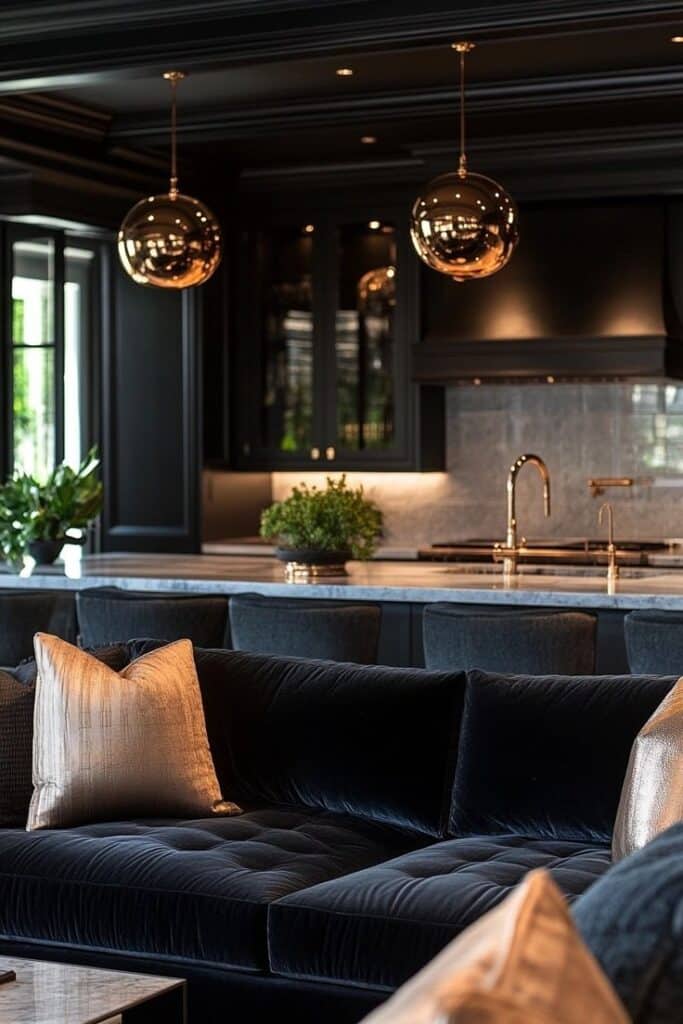
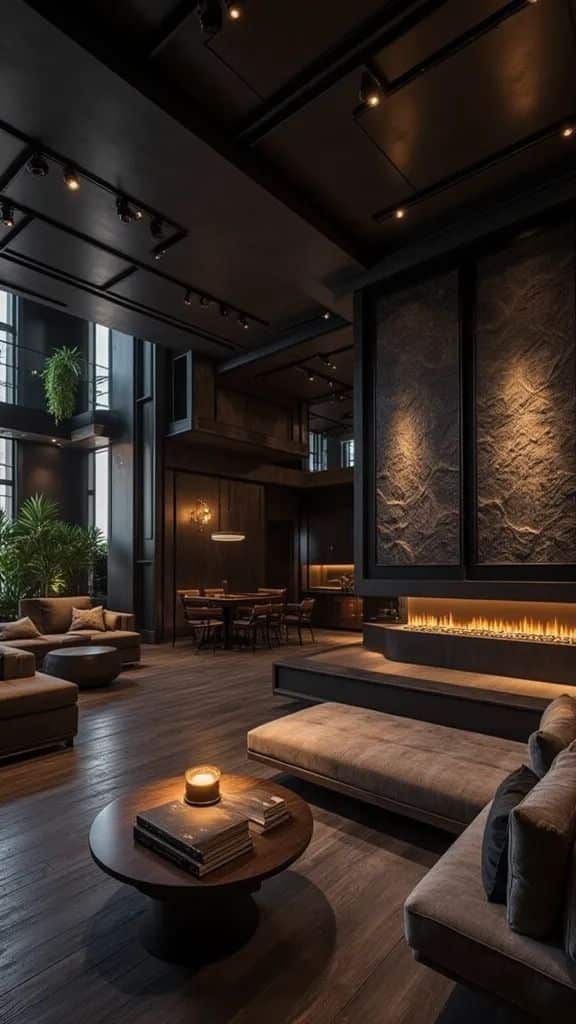
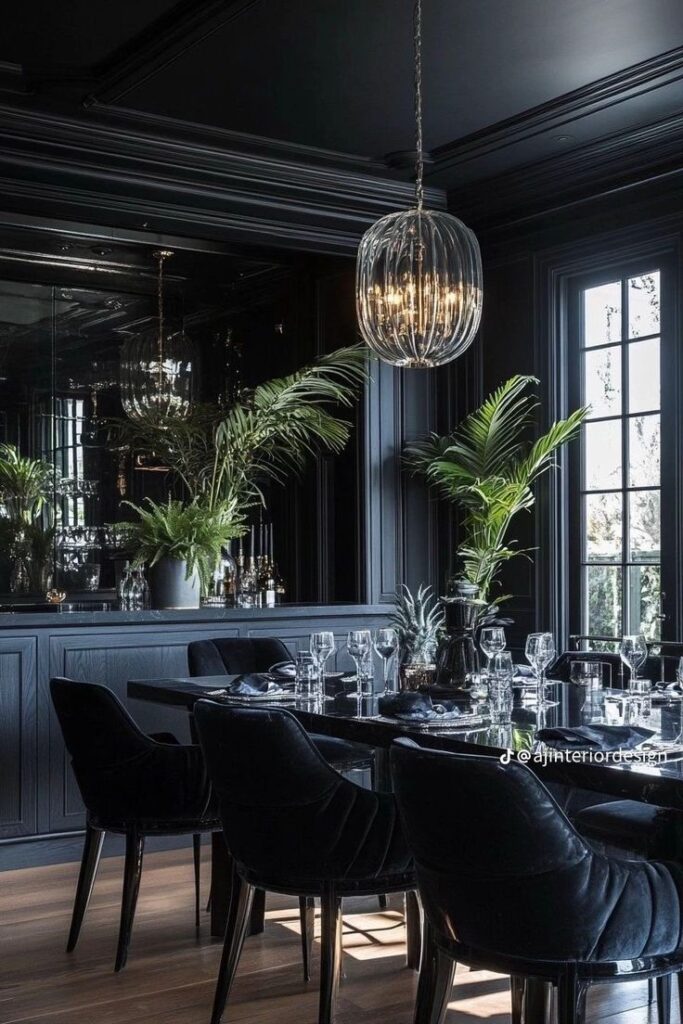
Strategic lighting transforms dark spaces by creating layers of illumination that complement deep-colored walls and furniture. Multiple light sources work together to eliminate shadows while maintaining the dramatic appeal of your dark interior elements.
Layered Lighting Techniques
Layered lighting combines three distinct types of illumination to brighten dark rooms effectively. Ambient lighting provides overall room brightness through ceiling fixtures or recessed lights.
Task lighting focuses on specific activities like reading or cooking. Accent lighting highlights architectural features or artwork while adding visual interest.
Position your ambient sources to bounce light off lighter surfaces in the room. This amplifies the overall brightness without washing out your dark accent walls or furniture.
Task lighting becomes crucial in dark interiors where shadows naturally form. Place these lights strategically near seating areas, workspaces, or dining tables.
Accent lighting creates depth and prevents your space from feeling flat. Use track lighting or picture lights to illuminate textured walls or decorative elements.
Using Floor and Table Lamps
Floor and table lamps offer flexible lighting solutions that brighten dark corners and create inviting atmospheres. Torchiere floor lamps direct light upward, bouncing illumination off ceilings to spread throughout the room.
Position floor lamps behind dark furniture to create a rim lighting effect. This technique separates furniture from dark walls while adding warmth to the space.
Table lamps provide localized brightness on side tables, desks, or console tables. Choose lamps with light-colored or metallic bases to reflect additional light.
Use lampshades in white or cream colors to maximize light output. Darker lampshades absorb light and counteract your brightening efforts.
Place multiple lamps at varying heights throughout your room. This creates visual rhythm while ensuring even light distribution across all areas.
Incorporating Dimmer Switches
Dimmer switches provide precise control over lighting intensity in dark interiors. They allow you to adjust brightness based on time of day, activities, or desired mood.
Install dimmers on overhead fixtures to balance ambient lighting with your dark color scheme. Lower settings maintain atmosphere while higher settings provide functional brightness.
Dimmer compatibility varies by bulb type, so verify your LED or incandescent bulbs work properly. Some LED bulbs flicker or buzz when dimmed with incompatible switches.
Smart dimmers offer preset lighting scenes for different occasions. Program bright settings for cleaning or detailed tasks, and softer settings for relaxation.
Consider installing dimmer switches on multiple circuits to control different lighting zones independently. This flexibility maximizes your dark interior’s versatility throughout the day.


